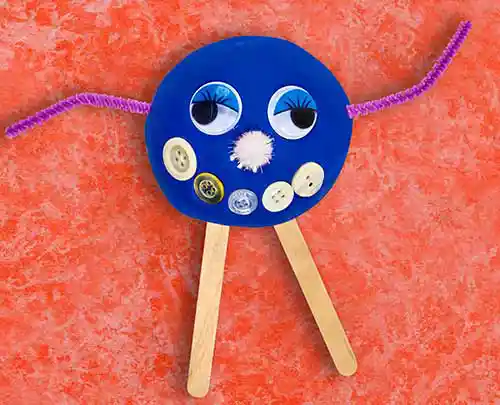Silly Dough Creatures

Playdough Art Activity for Kids
Use a variety of “loose parts” and modeling dough to create silly creatures.
What are loose parts? Loose parts are open-ended and versatile materials that can be used in a variety of ways. They can be found, bought, taken out of your recycling bin, or even taken from other art projects and repurposed. With loose parts children can use their imaginations to create in endless ways. Some examples of loose parts can be found in our materials list below.
Use a variety of “loose parts” and modeling dough to create silly creatures.What are loose parts? Loose parts are open-ended and versatile materials that can be used in a variety of ways. They can be found, bought, taken out of your recycling bin, or even taken from other art projects and repurposed. With loose parts children can use their imaginations to create in endless ways. Some examples of loose parts can be found in our materials list below.
Ages/Grades
Preschool, Early Elementary
Learning Domains
Language, Fine Motor, Social Emotional
Materials
• Pom poms
• Beads
• Other dough tools, such as cutters or textured rolling pins (optional)
• Any other found or recyclable materials, such as pouch tops, mosaic tiles, paper straws, etc. (optional)
Ready, Set, Create!
![]() Place the materials out on your tray or work surface.
Place the materials out on your tray or work surface.
![]() Organize the materials in an interesting and enticing way to create an “Invitation to Play.”
Organize the materials in an interesting and enticing way to create an “Invitation to Play.”
![]() Try grouping together similar materials or arranging them by size or color.
Try grouping together similar materials or arranging them by size or color.
![]() Encourage children to use the materials to create creatures!
Encourage children to use the materials to create creatures!


Engage Children in Conversation
Comment on what you observe, such as “I notice you put three wiggle eyes on your dough” or “What do you think will happen if you roll the dough with this texture roller?
Ask children open ended questions that encourage critical thinking, such as:
Which materials will you use to create your creature? Why will you choose these materials?
Will you name your creature? What will you name it?
Where will your creature live?
Will your creature eat food? What kinds of food will it eat?
For very young children, try asking “either/or” questions, such as “are you using the blue or the yellow dough?” “Is your creature thick or flat?”
Extensions
Adapt this activity to any unit of study by varying the dough colors and loose parts that are available. For example, if studying bears and hibernation, choose bear-like dough colors, such as brown, black, and white. Real-life photographs of hibernating animals and their habitats provide inspiration and spark curiosity.
For a unit on social and emotional learning, provide skin-tone dough colors, photographs of facial expressions along with mirrors and children can create faces using loose parts to represent different feelings.
Modifications
![]() Try using large and easily graspable loose parts with the dough, as well as smaller pieces, so that children have a variety of options depending upon their motor abilities.
Try using large and easily graspable loose parts with the dough, as well as smaller pieces, so that children have a variety of options depending upon their motor abilities.
![]() For those who prefer not to touch the dough, try placing dough inside a clear zippered pouch or bag (taped shut). You can also offer dough tools, such as rollers or stampers, so that they can mold the dough without using their hands. They can also use longer loose parts, such as cut straws and chenille stems to poke into the dough without touching it directly.
For those who prefer not to touch the dough, try placing dough inside a clear zippered pouch or bag (taped shut). You can also offer dough tools, such as rollers or stampers, so that they can mold the dough without using their hands. They can also use longer loose parts, such as cut straws and chenille stems to poke into the dough without touching it directly.
